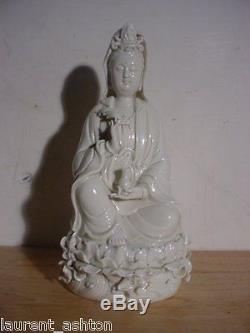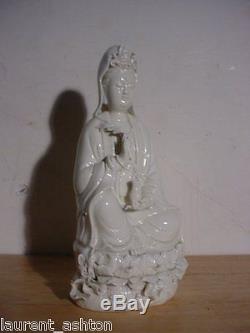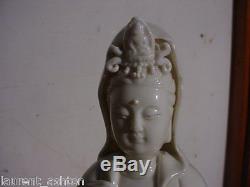
- Index
- Age
- 1636年-1912年 (5)
- 1736-1795 (6)
- 1736-1796年 (4)
- 1800-1849 (103)
- 1850-1899 (512)
- 1850-1900 (5)
- 1861-1875 (4)
- 18th Century (7)
- 1900-1940 (205)
- 19th Century (15)
- 960-1279年 (16)
- 960年—1279年 (37)
- Old (8)
- Post-1940 (130)
- Pre-1800 (381)
- Pre-1900 (3)
- Qing Dynasty (8)
- Unknown (288)
- 1850 (4)
- 1900 (19)
- Other (2828)
- Animal Type
- Product
- Sub-type
- Theme
- Type
Blanc De Chine Chinese Porcelain Statue Guanyin Kwanyin Quanyin Qing / 20th Cent











BLANC DE CHINE GUANYIN DIETY STATUE WITH IMPRESSED SEAL. THIS QUAN YIN BLANC DE CHINE PORCELAIN STATUE IS IN EXCELLENT CONDITION AND HAS FINE ART QUALITY DETAILS. THERE IS A TRACE OF IMPRESSED CHINESE CHARACTER SEAL MARKS WHICH CANNOT BE DECIPHERED DUE TO GLAZING AFTER IT WAS FIRED. THE DIMENSIONS ARE: 10.5" X 5". THE EXACT AGE IS UNKNOWN.
PROVENANCE IS FROM AN ESTATE IN MASSACHUSETTES, EAST COAST, USA. Here is some extensive historical information on Guanyin courtesy of Wikipedia.
From Wikipedia, the free encyclopedia. For the Chen Dynasty empress whose Buddhist nun name was "Guanyin", see Empress Shen Wuhua. For the shrine in Repulse Bay, see Kwun Yam Shrine.
Northern Song Dynasty wood carving of Guanyin, c. The Sounds (or Cries) of the World.
Quan Âm Quán Th Âm. You may see question marks, boxes, or other symbols.The name Guanyin is short for Guanshiyin , which means Observing. She is also sometimes referred to as Guanyin Pusa simplified Chinese.
Kuan-yin Pu-sah; literally "Bodhisattva Guanyin". Some Buddhists believe that when one of their adherents departs from this world, they are placed by Guanyin in the heart of a lotus, and then sent to the western pure land. It is generally accepted among East Asian adherents that Guanyin originated as the Sanskrit. Commonly known in English as the Mercy Goddess or Goddess of Mercy. Guanyin is also revered by Chinese Taoists.
(or Daoists) as an Immortal. There are other stories about Guanyin's origins that are not directly related to Avalokitevara.
Names in other Asian countries. Guanyin and the Thousand Arms. Guanyin and the Filial Parrot.
Guanyin and Chinese folk belief. Guanyin and the Virgin Mary.
Gunyn is a translation from the Sanskrit Avalokitasvara , referring to the Mahyna bodhisattva of the same name. Another later name for this bodhisattva is Gunzìzài simplified Chinese. It was initially thought that the Chinese mis-transliterated the word Avalokitevara as Avalokitasvara which explained why Xuanzang.
Translated it as Gunzìzài instead of Gunyn. However, according to recent research, the original form was indeed Avalokitasvara with the ending a-svara ("sound, noise"), which means "sound perceiver", literally "he who looks down upon sound" i.
The cries of sentient beings who need his help; a-svara can be glossed as ahr-svara , "sound of lamentation". This is the exact equivalent of the Chinese translation Gunyn. This etymology was furthered in the Chinese by the tendency of some Chinese translators, notably Kumarajiva. To use the variant Gunshìyn , literally "he who perceives the world's lamentations" -- wherein lok was read as simultaneously meaning both "to look" and "world" Skt. Direct translations from the Sanskrit name Avalokitasvara include. The name Avalokitasvara was later supplanted by the Avalokitevara form containing the ending -vara , which does not occur in Sanskrit before the seventh century. The original form Avalokitasvara already appears in Sanskrit fragments of the fifth century. The original meaning of the name "Avalokitasvara" fits the Buddhist understanding of the role of a bodhisattva. The reinterpretation presenting him as an vara shows a strong influence of aivism. As the term vara was usually connected to the Hindu notion of iva.As a creator god and ruler of the world. Some attributes of such a god were transmitted to the bodhisattva, but the mainstream of those who venerated Avalokitevara upheld the Buddhist rejection of the doctrine of any creator god.
Direct translations from the Sanskrit name Avalokitevara include. Due to the devotional popularity of Guanyin in East Asia, she is known by many names, most of which are simply the localised pronunciations of "Guanyin" or "Guanshiyin". In China, Guanshiyin was changed to Guanyin due to the unacceptability of the original under the naming taboo. Whose personal name was Li Shimin (contains the Chinese character shi).
In Macau, Hong Kong and Guangdong, the name is pronounced Kwun Yum or Kun Yum in the Cantonese language. , occasionally Kan'on , or more formally Kanzeon.The same characters as Guanshiyin ; the spelling Kwannon , based on a pre-modern. Which was named for Guanyin.
Guanyin is called Gwan-eum or Gwanse-eum. She is called Kuan Im Thai. , Phra Mae Kuan Im Thai. , or Chao Mae Kuan Im Thai. The name is Quan Âm. The name is Kwan Im or Dewi Kwan Im referring the word Dewi as Devi or Goddess. She is also called Mak Kwan Im referring the word Mak as Mother. The name is "Preah Mae Kun Ci Iem". In these same countries, the variant Guanzizai lit. "Lord of Contemplation" and its equivalents are also used, such as in the Heart Sutra. An early Indian statue of Avalokitasvara Bodhisattva. Guanyin as a male bodhisattva. Guanyin is the Chinese name for Avalokitevara. However, folk traditions in China and other East Asian countries have added many distinctive characteristics and legends. Avalokitevara was originally depicted as a male bodhisattva, and therefore wears chest-revealing clothing and may even sport a moustache. Although this depiction still exists in the Far East, Guanyin is more often depicted as a woman in modern times. Additionally, some people believe that Guanyin is androgynous. Saddharma Puarka Stra describes Avalokitevara as a bodhisattva who can take the form of any type of male or female, adult or child, human or non-human being, in order to teach the Dharma to sentient beings. This text and its thirty-three manifestations of Guanyin, of which seven are female manifestations, is known to have been very popular in Chinese Buddhism as early as in the Sui Dynasty. Additionally, Tan Chung notes that according to the doctrines of the Mahyna stras themselves, it does not matter whether Guanyin is male, female, or genderless, as the ultimate reality is in emptiness Skt. Representations of the bodhisattva in China prior to the Song Dynasty. (9601279) were masculine in appearance.Images which later displayed attributes of both genders are believed to be in accordance with the Lotus Sutra. Where Avalokitesvara has the supernatural power of assuming any form required to relieve suffering, and also has the power to grant children possibly relating to the fact that in this Sutra, unlike in others, both men and women are believed to have the ability to achieve enlightenment.
Because this bodhisattva is considered the personification of compassion and kindness, a mother-goddess and patron of mothers and seamen, the representation in China was further interpreted in an all-female form around the 12th century. In the modern period, Guanyin is most often represented as a beautiful, white-robed woman, a depiction which derives from the earlier Pandaravasini form. In some Buddhist temples and monasteries, Guanyin's image is occasionally that of a young man dressed in Northern Song Dynasty. Buddhist robes and seated gracefully.He is usually depicted looking or glancing down, symbolising that Guanyin continues to watch over the world. In China, Guanyin is sometimes shown in a white flowing robe and usually wears necklaces of Indian/Chinese royalty. In her left hand is a jar containing pure water, and the right holds a willow.
The crown usually depicts the image of Amitabha. There are also regional variations of Guanyin depictions. Region of China, for example, a popular depiction of Guanyin is as a maiden dressed in Tang Dynasty.
Style clothing carrying a fish basket. A popular image of Guanyin as both Guanyin of the South Sea and Guanyin With a Fish Basket can be seen in late 16th century Chinese encyclopedias and in prints that accompany the novel Golden Lotus. In Chinese art, Guanyin is often depicted either alone, standing atop a dragon, accompanied by a white parrot. Flanked by two children, or flanked by two warriors. The two children are her acolytes who came to her when she was meditating at Mount Putuo.
The girl is called Longnü. The two warriors are the historical general Guan Yu. From the late Han Dynasty. Who appears in the Chinese classical novel Fengshen Bang.
The Buddhist tradition also displays Guanyin, or other buddhas and bodhisattvas, flanked with the above mentioned warriors, but as bodhisattvas who protect the temple and the faith itself. Guanyin Shan (Guanyin Mountain) in Dongguan.
In Chinese Buddhist iconography, Guanyin is often depicted as meditating or sitting alongside one of the Buddhas and usually accompanied by another bodhisattva. The buddha and bodhisattva that are portrayed together with Guanyin usually follow whichever school of Buddhism they represent. In the Pure Land school. For example, Guanyin is frequently depicted on the left of Amitabha.Buddha, while on the buddha's right is another bodhisattva called Mahasthamaprapta. Temples that revere the bodhisattva Ksitigarbha. Usually depict him meditating beside Amitabha and Guanyin.
Along with Buddhism, Guanyin's veneration was introduced into China as early as the 1st century CE, and reached Japan through Korea soon after Buddhism was first introduced into the country in the mid-7th century. Some Taoist records claim Guanyin was a Chinese female who became an immortal during the Shang Dynasty. More recently in Europe and America, a new wave of believers have spread a devotional cult beyond Buddhism, Taoism and traditional folk beliefs. Guanyin is not only a bodhisattva or a god but a focus of devotion by some Eastern New Age movements. Guanyin, sitting in the lotus position. The damaged hands probably performing dharmacakramudra , a gesture that signifies the moment when Buddha put the wheel of learning in motion. Song/Jin period, late 13th century. It is now located in the History Museum in Hanoi. Part of a series on. One Buddhist legend from the Complete Tale of Guanyin and the Southern Seas Chinese. Presents Guanyin as vowing to never rest until she had freed all sentient beings from the samsara. Despite strenuous effort, she realised that there were still many unhappy beings yet to be saved.After struggling to comprehend the needs of so many, her head split into eleven pieces. Upon seeing her plight, gave her eleven heads to help her hear the cries of those who are suffering.
Upon hearing these cries and comprehending them, Avalokitesvara attempted to reach out to all those who needed aid, but found that her two arms shattered into pieces. Once more, Amitabha came to her aid and appointed her a thousand arms to let her reach out to those in need. Many Himalayan versions of the tale include eight arms with which Avalokitesvara skillfully upholds the Dharma. Each possessing its own particular implement, while more Chinese-specific versions give varying accounts of this number.In China, it is said that fishermen used to pray to her to ensure safe voyages. The titles Guanyin of the Southern Ocean and "Guanyin (of/on) the Island" stem from this tradition. Another story from the Precious Scroll of Fragrant Mountain. Describes an incarnation of Guanyin as the daughter of a cruel king who wanted her to marry a wealthy but uncaring man. The story is usually ascribed to the research of the Buddhist monk Chiang Chih-ch'i during the 11th century.
The story is likely to have its origin in Taoism. When Chiang penned the work, he believed that the Guanyin we know today was actually a princess called Miaoshan , who had a religious following on Fragrant Mountain. Despite this there are many variants of the story in Chinese mythology. According to the story, after the king asked his daughter Miaoshan to marry the wealthy man, she told him that she would obey his command, so long as the marriage eased three misfortunes.The king asked his daughter what were the three misfortunes that the marriage should ease. Miaoshan explained that the first misfortune the marriage should ease was the suffering people endure as they age. The second misfortune it should ease was the suffering people endure when they fall ill.
The third misfortune it should ease was the suffering caused by death. If the marriage could not ease any of the above, then she would rather retire to a life of religion forever. When her father asked who could ease all the above, Miaoshan pointed out that a doctor was able to do all of these. Kannon statue in Daien'in Mt. Her father grew angry as he wanted her to marry a person of power and wealth, not a healer. He forced her into hard labour and reduced her food and drink but this did not cause her to yield. Every day she begged to be able to enter a temple and become a nun. Her father eventually allowed her to work in the temple, but asked the monks. To give her the toughest chores in order to discourage her. The monks forced Miaoshan to work all day and all night, while others slept, in order to finish her work.However, she was such a good person that the animals living around the temple began to help her with her chores. Her father, seeing this, became so frustrated that he attempted to burn down the temple. Miaoshan put out the fire with her bare hands and suffered no burns. Now struck with fear, her father ordered her to be put to death. In one version of this legend, when Guanyin was executed, a supernatural tiger took her to one of the more hell-like realms of the dead.
However, instead of being punished like the other spirits of the dead, Guanyin played music, and flowers blossomed around her. This completely surprised the hell guardian. The story says that Guanyin, by merely being in that Naraka.
(hell), turned it into a paradise. A variant of the legend says that Miaoshan allowed herself to die at the hand of the executioner. According to this legend, as the executioner tried to carry out her father's orders, his axe shattered into a thousand pieces. He then tried a sword which likewise shattered.He tried to shoot Miaoshan down with arrows but they all veered off. Finally in desperation he used his hands. Miaoshan, realising the fate that the executioner would meet at her father's hand should she fail to let herself die, forgave the executioner for attempting to kill her. It is said that she voluntarily took on the massive karmic guilt the executioner generated for killing her, thus leaving him guiltless.
It is because of this that she descended into the Hell-like realms. While there, she witnessed first-hand the suffering and horrors that the beings there must endure, and was overwhelmed with grief. Filled with compassion, she released all the good karma she had accumulated through her many lifetimes, thus freeing many suffering souls back into Heaven and Earth.
In the process, that Hell-like realm became a paradise. It is said that Yama. The ruler of hell, sent her back to Earth to prevent the utter destruction of his realm, and that upon her return she appeared on Fragrant Mountain. Another tale says that Miaoshan never died, but was in fact transported by a supernatural tiger, believed to be the Deity of the Place. The legend of Miaoshan usually ends with Miaozhuangyan, Miaoshan's father, falling ill with jaundice. No physician was able to cure him. Then a monk appeared saying that the jaundice could be cured by making a medicine out of the arm and eye of one without anger.The monk further suggested that such a person could be found on Fragrant Mountain. When asked, Miaoshan willingly offered up her eyes and arms. Miaozhuangyan was cured of his illness and went to the Fragrant Mountain to give thanks to the person.
When he discovered that his own daughter had made the sacrifice, he begged for forgiveness. The story concludes with Miaoshan being transformed into the Thousand Armed Guanyin, and the king, queen and her two sisters building a temple on the mountain for her.
She began her journey to heaven. And was about to cross over into heaven when she heard a cry of suffering from the world below.She turned around and saw the massive suffering endured by the people of the world. After her return to Earth, Guanyin was said to have stayed for a few years on the island of Mount Putuo. Where she practised meditation and helped the sailors and fishermen who got stranded.
Guanyin is frequently worshipped as patron of sailors and fishermen due to this. She is said to frequently becalm the sea when boats are threatened with rocks.Legend has it that Shancai also called Sudhana. Was a disabled boy from India who was very interested in studying the dharma. When he heard that there was a Buddhist teacher on the rocky island of Putuo he quickly journeyed there to learn.
Upon arriving at the island, he managed to find Guanyin despite his severe disability. Guanyin, after having a discussion with Shancai, decided to test the boy's resolve to fully study the Buddhist teachings.
She conjured the illusion of three sword-wielding pirates running up the hill to attack her. Guanyin took off and dashed to the edge of a cliff, the three illusions still chasing her.
Shancai, seeing that his teacher was in danger, hobbled uphill. Guanyin then jumped over the edge of the cliff, and soon after this the three bandits followed. Shancai, still wanting to save his teacher, managed to crawl his way over the cliff edge.Shancai fell down the cliff but was halted in midair by Guanyin, who now asked him to walk. Shancai found that he could walk normally and that he was no longer crippled. When he looked into a pool of water he also discovered that he now had a very handsome face. From that day forth, Guanyin taught Shancai the entire dharma. 14th Century Mu Qi Recreation, Chinese, Ming Period.
Many years after Shancai Sudhana. Became a disciple of Guanyin, a distressing event happened in the South China Sea. The son of one of the Dragon Kings.
(a ruler-god of the sea) was caught by a fisherman while taking the form of a fish. Being stuck on land, he was unable to transform back into his dragon form. His father, despite being a mighty Dragon King, was unable to do anything while his son was on land. Distressed, the son called out to all of Heaven and Earth. It was causing quite a stir as it was alive hours after being caught. This drew a much larger crowd than usual at the market.The crowd, now angry at someone so daring, was about to pry him away from the fish when Guanyin projected her voice from far away, saying A life should definitely belong to one who tries to save it, not one who tries to take it. The crowd, realising their shameful actions and desire, dispersed. Paintings of Guanyin today sometimes portray her holding a fish basket, which represents the aforementioned tale. But the story does not end there. As a reward for Guanyin saving his son, the Dragon King sent his granddaughter, a girl called Longnü.
("dragon girl"), to present Guanyin with the Pearl of Light. The Pearl of Light was a precious jewel owned by the Dragon King that constantly shone.Longnü, overwhelmed by the presence of Guanyin, asked to be her disciple so that she might study the dharma. Guanyin accepted her offer with just one request: that Longnü be the new owner of the Pearl of Light.
In popular iconography, Longnü and Shancai are often seen alongside Guanyin as two children. Longnü is seen either holding a bowl or an ingot. Which represents the Pearl of Light, whereas Shancai is seen with palms joined and knees slightly bent to show that he was once crippled.
The Precious Scroll of the Parrot Chinese. Tells the story of a parrot who becomes a disciple of Guanyin.
During the Tang Dynasty a small parrot ventures out to search for its mother's favourite food upon which it is captured by a poacher (parrots were quite popular during the Tang Dynasty). When it managed to escape it found out that its mother had already died. The parrot grieved for its mother and provides her with a proper funeral. It then sets out to become a disciple of Guanyin. In popular iconography, the parrot is coloured white and usually seen hovering to the right side of Guanyin with either a pearl or a prayer bead clasped in its beak. The parrot becomes a symbol of filial piety. Dry-lacquer sculpture in the "Water-moon Guanyin" theme. When the people of Quanzhou. Getting on a boat, she offered to marry any man who could hit her with a piece of silver from the edge of the water. One of the Eight Immortals. Helped a merchant hit Guanyin in the hair with silver powder, which floated away in the water. Guanyin bit her finger and a drop of blood fell into the water, but she vanished. This blood was swallowed by a washer woman, who gave birth to Chen Jinggu or Lady Linshui ; the hair was turned into a female white snake and sexually used men and killed rival women. The snake and Chen were to be mortal enemies. The merchant was sent to be reborn as Liu Qi. Chen was a beautiful and talented girl, but did not wish to marry Liu Qi. Instead, she fled to Mount Lu. Where she learned many Taoist. Destiny eventually caused her to marry Liu and she became pregnant. A drought in Fujian caused many people to ask her to call for rain, which was a ritual that could not be performed while pregnant. She temporarily aborted her child, which was killed by the white snake.Chen managed to kill the snake with a sword, but died either of a miscarriage or hemorrhage; she was able to complete the ritual, and ended drought. This story is popular in Zhejiang. Due to her symbolising compassion, in East Asia. Guanyin is associated with vegetarianism.
Are generally decorated with her image, and she appears in most Buddhist vegetarian pamphlets and magazines. Salle des Martyrs, Paris Foreign Missions Society.A portrait of Guanyin by User:Javier Biedma. In Chinese Buddhism, Guanyin is synonymous with the bodhisattva Avalokitesvara. Among the Chinese, Avalokitesvara is almost exclusively called Guanshiyin Pusa. The Chinese translation of many Buddhist sutras has in fact replaced the Chinese transliteration of Avalokitesvara with Guanshiyin Some Daoist scriptures give her the title of Guanyin Dashi , and sometimes informally as Guanyin Fozu.
In Chinese culture, the popular belief and worship of Guanyin as a goddess. By the populace is generally not viewed to be in conflict with the bodhisattva Avalokitesvara's nature. In fact the widespread worship of Guanyin as a "Goddess of Mercy and Compassion".Is seen as the boundless salvific nature of bodhisattva Avalokitesvara at work in Buddhism, this is referred to as Guanyin's "skillful means", or upaya. The Buddhist canon states that bodhisattvas can assume whatsoever gender and form is needed to liberate beings from ignorance and dukkha. With specific reference to Avalokitesvara, he is stated both in the Lotus Sutra. (Chapter 25 "Perceiver of the World's Sounds" or "Universal Gateway"), and the Surangama Sutra. To have appeared before as a woman or a goddess to save beings from suffering and ignorance.
Some Buddhist schools refer to Guanyin both as male and female interchangeably. Gender is no obstacle to attaining enlightenment or nirvana. The Buddhist concept of non-duality applies here. In the Goddess chapter clearly illustrates an enlightened being who is also a female and deity. In the Lotus Sutra a maiden became enlightened in a very short time. The view that the bodhisattva Avalokitesvara. Is also the goddess Guanyin does not seem contradictory to Buddhist beliefs. Given that bodhisattvas are known to incarnate at will as living people according to the sutras, the princess Miaoshan is generally viewed as an incarnation of Avalokitesvara. Guanyin is immensely popular among Chinese Buddhists, especially those from devotional schools. She is generally seen as a source of unconditional love and, more importantly, as a saviour. In her bodhisattva vows, Guanyin promises to answer the cries and pleas of all sentient beings and to liberate them from their own karmic woes.Based on the Lotus Sutra and the Shurangama sutra, Avalokitesvara is generally seen as a saviour, both spiritually and physically. The sutras state that through his saving grace even those who have no chance of being enlightened can be enlightened, and those deep in negative karma can still find salvation through his compassion. Guanyin is described as the "Barque of Salvation".
She temporarily liberates beings out of the Wheel of Samsara into the Pure Land, where they will have the chance to accrue the necessary merit so as to be a Buddha in one lifetime. Even among Chinese Buddhist schools that are non-devotional, Guanyin is still highly venerated. Instead of being seen as an active external force of unconditional love and salvation, the personage of Guanyin is highly revered as the principle of compassion, mercy and love. The act, thought and feeling of compassion and love is viewed as Guanyin. A merciful, compassionate, loving individual is said to be Guanyin.A meditative or contemplative state of being at peace with oneself and others is seen as Guanyin. In the Mahayana canon, the Heart Sutra. Is ascribed entirely to Guanyin. This is unique, as most Mahayana Sutras are usually ascribed to Shakyamuni Buddha. And the teachings, deeds or vows of the bodhisattvas are described by Shakyamuni Buddha.
Guanyin describes to the arhat. The nature of reality and the essence of the Buddhist teachings. The famous Buddhist saying "Form is emptiness, emptiness is form" comes from this sutra. Historically worshiped a deity known as Kimnara. And progenitor of the Shaolin staff method.Kimnara was originally called "Narayana" not to be confused with Vishnu. , which was a name for the bodhisattva Vajrapani. However, Shaolin considered Vajrapani's Kimnara form to be an emanation of Guanyin. Guanyin is an extremely popular Goddess in Chinese folk belief and is worshiped in Chinese communities throughout East and South East Asia. Guanyin is revered in the general Chinese population due to her unconditional love, compassion and mercy.
She is generally regarded by many as the protector of women and children. By this association she is also seen as a fertility goddess capable of granting children. An old Chinese superstition involves a woman wishing to have a child offering a shoe at a Guanyin Temple. Guanyin is also seen as the champion of the unfortunate, the sick, the disabled, the poor, and those in trouble.Some coastal and river areas of China regard her as the protector of fishermen, sailors, and generally people who are out at sea, thus many also come to believe that Mazu. The Daoist goddess of the sea, is a manifestation of Guanyin. Due to her association with the legend of the Great Flood.
Where she sent down a dog. Grains in its tail after the flood, she is worshiped as a rice goddess. In some quarters, especially among business people and traders, she is looked upon as a Goddess of Luck and Fortune.
In recent years there have been claims of her being the protector of air travelers. Guanyin and child, similar to a Madonna and Child.
Some Buddhist and Christian observers have commented on the similarity between Guanyin and Mary. The mother of Jesus Christ. This can be attributed to the representation of Guanyin holding a child in Chinese art and sculpture; it is believed that Guanyin is the patron saint of mothers and grants parents filial children. Foundation, a Taiwanese Buddhist organisation, noticed the similarity between this form of Guanyin and the Virgin Mary, the organisation commissioned a portrait of Guanyin and a baby that resembles the typical Roman Catholic Madonna and Child. In Japan, when Christianity was banned and punishable by death, some underground Christian groups venerated the Virgin Mary disguised as a statue of Kannon; such statues are known as Maria Kannon. Many had a cross hidden in an inconspicuous location. It is suggested the similarity comes from the conquest and colonisation by Spain during the 16th century, when engravings of the Virgin Mary influenced Asian cultures. Evident by this carving of the Virgin Mary by an Chinese carver. The fourth tallest statue in the world. (Mount Putuo), an island in Zhejiang. Province, China, considered to be the bodhimandala. Of Cho Lon, Saigon, Vietnam.Tara is the female aspect of Avalokitesvara in Tibetan Buddhism. (creator of the Thousand Hand Guanyin dance).
The Heart Sutra: The Womb of the Buddhas (2004) Shoemaker 7 Hoard. Across the Himalayan Gap: An Indian Quest for Understanding China. Williams, Charles Alfred Speed (2006). Chinese Symbolism and Art Motifs.
Which refers to her as the Daoist Queen of Heaven and Holy Mother. Personal salvation and filial piety: two precious scroll narratives of Guanyin and her acolytes. The Shaolin Monastery: History, Religion, and the Chinese Martial Arts. "Victoria and Albert Museum, 2004 London Proms Performing Art Lecture with Christopher Cook and Marjorie Trusted". (mp4 audio, requires Apple QuickTime). Pregadio, Fabrizio (2008), The encyclopedia of Taoism, Volume 1. Princeton, NJ: Psychology Press, ISBN. Suzanne E Cahill: Transcendence & Divine Passion.Martin Palmer, Jay Ramsay, Man-Ho Kwok: Kuan Yin. Myths and Prophecies of the Chinese Goddess of Compassion , Thorsons, San Francisco 1995, ISBN 1-85538-417-5.
William Stoddart: Outline of Buddhism , The Foundation for Traditional Studies, Oakton, Virginia, 1996. Kuan Ming: Popular Deities of Chinese Buddhism , Buddha Dharma Education Association Inc, 1985. John Blofeld: Bodhisattva of Compassion. The Mystical Tradition of Kuan Yin , Shambhala, Boston 1988, ISBN 0-87773-126-8.
Miao Yun: Teachings in Chinese Buddhism: Selected Translation of Miao Yun , Buddha Dharma Education Association Inc, 1995. The universal door of Guanshi Yin Bodhisattva (The bodhisattva who contemplates the sounds of the world). (Translated by The Buddhist Text Translation Society in USA). Wikimedia Commons has media related to: Guan Yin. Sinicization of Buddhism - White Robe Guan Yin. Explanation of how Avalokiteshvara transformed into Guan Yin in Chinese Buddhism. Explanation on Kuan Yin and the Heart Sutra. Detailed history of Miao Shan.Tzu-Chi organisation: Kuan Yin, Buddhist perspective. By Buddhist Text Translation Society. Chapter 6 details Kuan Yin's powers.
Kwan Yin and the Swallows. Images and travelling impressions - inish. Four Heavenly Kings (Sì Tinwáng). Places where the Buddha stayed. Basic points unifying Theravada and Mahayana.
History of Buddhism in India. Decline of Buddhism in India. Buddhism and the Roman world. Silk Road transmission of Buddhism. Thai temple art and architecture.Journey to the West characters. Female buddhas and supernatural beings. Buddhist deities, bodhisattvas, and demons. This page was last modified on 2 December 2012 at 22:26. Text is available under the Creative Commons Attribution-ShareAlike License.
The item "Blanc De Chine Chinese Porcelain Statue Guanyin Kwanyin Quanyin Qing / 20th Cent" is in sale since Friday, December 14, 2012. This item is in the category "Antiques\Asian Antiques\China\Figurines & Statues". The seller is "laurent_ashton" and is located in Reno, Nevada. This item can be shipped worldwide.
- Type: Vases
- Primary Material: Porcelain & Pottery
- Age: 1850-1899
- Region of Origin: China
- Original/Reproduction: Original
- Color: White
- Theme: Kwan-yin
- Featured Refinements: Blanc De Chine

